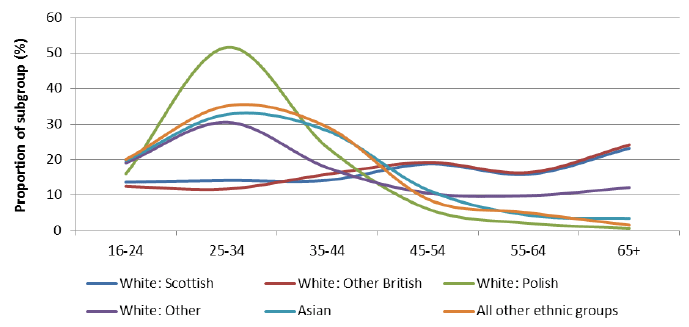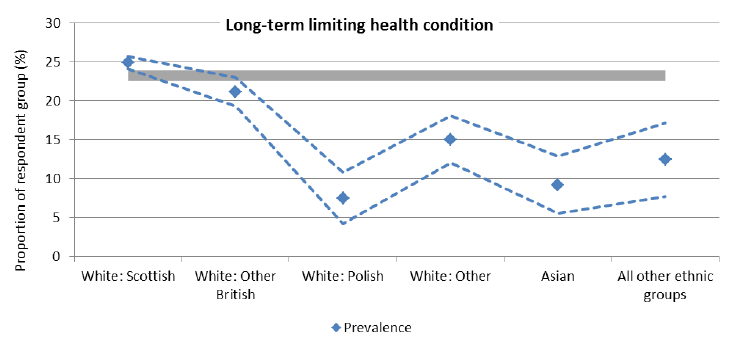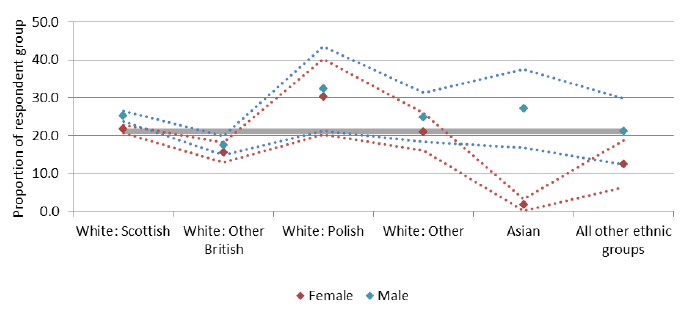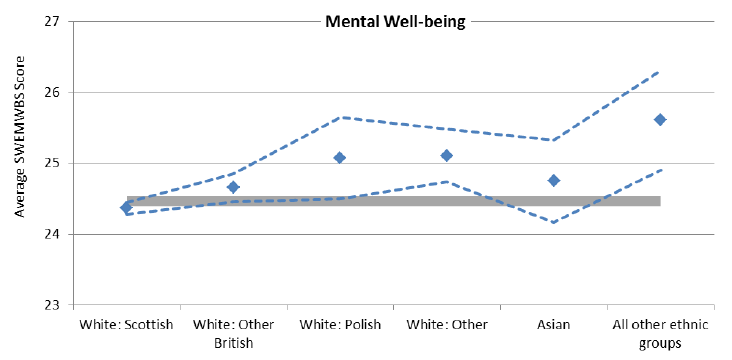Scottish Surveys Core Questions 2014
Official statistics publication on equality groups across a range of measures from harmonised questions across the major SG population surveys.
This document is part of a collection
4 Ethnicity
The ethnic group of respondents is collected in detail by the surveys contributing to the SSCQ. The full range of responses available to survey respondents is provided in Table 91.
We have tried to present the data on ethnic group in a way that would be most helpful to users, with consideration to producing analysis to reveal inequalities that highlight the need for action. However, in Scotland, many ethnic groups are small in number and this can often lead to statistical unreliability when analysing and presenting data drawn from a sample survey. This can hinder publication of detailed data because of the need to avoid identification of individuals.
In some instances we have tried to overcome this problem by combining categories. This is not an ideal solution as it can hide inequalities that occur between each of the separate categories, but it is often the option which provides the best balance between data utility, sensitivity and the protection of the individual. Our schema for doing so is provided in section 11.7.
Where it has been necessary to combine categories, we have tried to make the headings reflective of the individual categories that have been combined. We have tried to take account of the sensitivities around differing stakeholders' views of the ethnic group categories used in Scottish surveys. In the accompanying commentary we have used current terminology on ethnic group.
Summary Findings
- When the differing age profile of ethnic groups are taken into account, the "White: Other British" and "White: Other" groups have significantly higher levels of good/very good general health compared to the "White: Scottish" majority.
- Accounting for age differences, only the "White: Other British" groups is significantly different to the national average level of long-term limiting health conditions, around 4 percentage points lower than the "White: Scottish" majority.
- The "White: Polish" group has higher smoking rates than the national average; for "White: Other British" and "Asian" subgroups, the rate is lower. There are also significant differences between sexes across most ethnic groups, the prevalence among women being lower.
- Mental wellbeing is lower in the "White: Scottish" group than in all other "White" ethnic subgroups. Differences for the "Asian" and "All other ethnic groups" are not statistically significant after age standardisation.
- When age distribution is accounted for, there are no significant differences between ethnic groups in their provision of care at the 95% level. Although the estimates for "White: Polish" and "Asian" subgroups are considerably lower than the national average, the increase in confidence interval as a result of this calculation means these differences are not statistically significant.
- Perceptions of local crime rates in 2014 were approximately equal for the "White: Scottish" and "White: Other British" subgroups. This is a result of an increase for the "White: Scottish" and a decrease for the "White: Other British" groups since 2012, when "White: Scottish" had a lower level than "White: Other British".
After age standardisation, only the "White: Polish" group differs significantly from the national average. 84.2% reported crime has reduced or stayed the same over the past two years, a significantly higher level than other ethnic groups.
Figure 9: Age profile of ethnic groups , SSCQ 2014

There are significant differences in the age distribution of ethnic groups. While "White: Scottish" and "White: Other British" are very similar, other groups tend by varying degrees to be younger in general and to be in the 25-34 age group in particular. For this reason, age standardisation is applied to many of the analyses in the following section. For more information on this process, see section 11.10.
Table 30: Age profile of ethnic groups [36] , SSCQ 2014
| Proportion in Age Group (Row %) |
Adults |
Col% |
||||||
|---|---|---|---|---|---|---|---|---|
| 16-24 |
25-34 |
35-44 |
45-54 |
55-64 |
65+ |
|||
| White: Scottish |
13.7 |
14.2 |
14.2 |
18.8 |
15.9 |
23.2 |
3,457,400 |
78% |
| White: Other British |
12.5 |
11.8 |
15.9 |
19.3 |
16.4 |
24.2 |
579,100 |
13% |
| White: Polish |
16.1 |
51.6 |
23.4 |
6.2 |
2.1 |
0.7 |
76,700 |
2% |
| White: Other* |
19.1 |
30.5 |
17.7 |
10.6 |
9.9 |
12.2 |
167,400 |
4% |
| Asian** |
19.8 |
32.7 |
28.2 |
11.4 |
4.4 |
3.5 |
101,400 |
2% |
| All other ethnic groups*** |
20.1 |
35.2 |
29.2 |
8.9 |
5.1 |
1.6 |
50,200 |
1% |
Where statistical testing is used to identify differences between subgroups, the "White: Scottish" group - the most populous group in Scotland - is used as the basis for comparison. Where p-values are provided, a value of less than 0.05 indicates statistical significance at the 95% level. For more information about statistical tests, see section 11.11.
4.1 General Health
Ethnic groups other than "White:Scottish" report higher levels of good/very good general health. "White: Polish" and "White: Other" groups have the highest levels at around 88% and 86% respectively.
Table 31: General health by ethnic group, SSCQ 2014; changes from 2013 and 2012
| 2014 |
Change |
||||
|---|---|---|---|---|---|
| grp % |
+/- |
from 2013 |
from 2012 |
||
| Ethnicity |
White: Scottish |
72.6 |
± 0.8 |
-1.0 |
+0.0 |
| White: Other British |
76.6 |
± 1.9 |
-1.3 |
+2.4 |
|
| White: Polish |
87.8 |
± 4.9 |
-4.8 |
-2.4 |
|
| White: Other |
86.2 |
± 2.9 |
-1.4 |
+3.9 |
|
| Asian |
79.1 |
± 5.3 |
-3.5 |
-1.9 |
|
| All other ethnic groups |
84.8 |
± 5.2 |
-2.0 |
-5.7 |
|
This picture changes somewhat when the differing age profiles of the ethnic groups has been taken into account. Under age standardisation, the "White: Polish", "Asian" and "All other" ethnic groups are no longer statistically different from the "White:Scottish".
Only the "White: Other British" and "White: Other" remain significantly higher than the "White: Scottish" group under age standardisation.
Table 32: Good/very good general health - age standardised ethnic group result, SSCQ 2014
| Base level | Age standardised | ||
|---|---|---|---|
| White: Scottish | 72.6% | 73.1% | ± 0.8 |
| White: Other British | 76.6% | 77.6% | ± 1.9 |
| White: Polish | 87.8% | 74.2% | ± 15.2 |
| White: Other | 86.2% | 80.5% | ± 3.8 |
| Asian | 79.1% | 69.2% | ± 8.5 |
| All other ethnic groups | 84.8% | 72.3% | ± 12.4 |
4.2 Long-term Limiting Health Conditions
Figure 10: Long-term limiting health conditions by ethnic group

All ethnic groups except "White: Scottish" and "White: Other British" have lower prevalences of long-term limiting conditions than the national average. "White: Scottish" have a slightly higher prevalence than the national rate.
Table 33: Long-term limiting health conditions by ethnic group, SSCQ 2014; changes from 2013 and 2012
| 2014 |
Change |
|
|||||
|---|---|---|---|---|---|---|---|
| grp % |
+/- |
from 2013 |
from 2012 |
||||
| Ethnicity |
White: Scottish |
24.9 |
± 0.8 |
+1.4 |
|
-0.3 |
|
| White: Other British |
21.1 |
± 1.8 |
-0.8 |
-2.7 |
|
||
| White: Polish |
7.5 |
± 3.3 |
+1.1 |
-0.7 |
|||
| White: Other |
15.0 |
± 3.0 |
+3.0 |
-0.0 |
|||
| Asian |
9.2 |
± 3.7 |
+1.9 |
-1.6 |
|||
| All other ethnic groups |
12.4 |
± 4.7 |
+0.4 |
+1.2 |
|||
However, this indicator and ethnic group are both strongly correlated with age. Groups not identifying as "White: Scottish" or "White: Other British" tend to be considerably younger (see Table 30). When this relationship is accounted for through age standardisation, many of the apparent differences between ethnic groups disappear, as shown in Table 34.
Table 34: Long-term limiting health conditions - age standardised ethnic group results, SSCQ 2014
| Base level | Age standardised | ||
|---|---|---|---|
| White: Scottish | 24.9% | 24.4% | ± 0.8 |
| White: Other British | 21.1% | 20.2% | ± 1.8 |
| White: Polish | 7.5% | 24.9% | ± 16.0 |
| White: Other | 15.0% | 20.1% | ± 3.8 |
| Asian | 9.2% | 17.2% | ± 7.0 |
| All other ethnic groups | 12.4% | 24.0% | ± 12.5 |
The results of age standardisation among ethnic groups are that:
- "White: Scottish" is no longer significantly different from the national average level
- "White: Other British" drops just below the national average
- "All other ethnic groups" increase in prevalence to account for their younger age distributions, and are no longer distinguishable from national average levels.
Note also that the confidence intervals on the age standardised results increase by a large amount, almost 5 times larger for "White: Polish". This likely because a small number of older individuals are made to represent what is a large proportion of the population at national level.
4.3 Smoking
Figure 11: Smoking prevalence by ethnic group, SSCQ 2014

There are clear differences in smoking rates between ethnic groups, as shown in Figure 11. The "White: Other British" and "Asian" groups have lower smoking rates than the national average, while the "White: Polish" group has the highest rate at 32.6%.
Table 35: Smoking prevalence by ethnic group, SSCQ 2014; changes from 2013 and 2012
| 2014 |
Change |
|||||
|---|---|---|---|---|---|---|
| grp % |
+/- |
from 2013 |
from 2012 |
|||
| Ethnicity |
White: Scottish |
22.4 |
± 0.8 |
-1.0 |
-2.5 |
|
| White: Other British |
14.7 |
± 1.7 |
-1.9 |
-4.1 |
|
|
| White: Polish |
32.6 |
± 6.9 |
+1.2 |
-2.7 |
||
| White: Other |
19.5 |
± 3.7 |
-3.3 |
-4.2 |
||
| Asian |
12.5 |
± 4.6 |
-1.8 |
+1.8 |
||
| All other ethnic groups |
18.1 |
± 6.9 |
+1.2 |
+4.7 |
||
Across all ethnic groups, differences from the national average are accentuated by age standardisation, indicating that ethnic group is a determinate of smoking prevalence independent of age group.
Table 36: Smoking prevalence - age standardised ethnic groups, SSCQ 2014
| Base level | Age standardised | ||
|---|---|---|---|
| White: Scottish | 22.4% | 22.7% | ± 0.8 |
| White: Other British | 14.7% | 15.1% | ± 1.8 |
| White: Polish | 32.6% | 39.3% | ± 13.7 |
| White: Other | 19.5% | 17.9% | ± 3.5 |
| Asian | 12.5% | 11.8% | ± 4.9 |
| All other ethnic groups | 18.1% | 17.4% | ± 7.8 |
Smoking rates are significantly higher for men in all ethnic groups except "All other ethnic groups" where, although the point estimate is lower for women there is insufficient confidence for a statistical difference (see Figure 12) [37] .
Figure 12: Smoking prevalence by ethnic group and sex, SSCQ 2014

The picture was rather different in 2013, when the difference between sexes at national level was somewhat smaller (see section 2.3). In 2013 when ethnic groups are split by sex, for most groups the smoking rates do not differ significantly. However, in the "Asian" ethnic group, women have much lower smoking rates than men. Indeed "Asian" men have a similar smoking rate to the "White: Scottish" group at 27.2%, while only 1.8% of "Asian" women smoke cigarettes (see Figure 13).
Figure 13: Smoking prevalence by ethnic group and sex, SSCQ 2013

4.4 Mental Wellbeing
As shown in Figure 14, "White: Other" and "All other ethnic groups" have higher levels of mental wellbeing than the national average. A formal test shows that the "White: Other British" and "White: Polish" groups also have higher levels of mental wellbeing than the "White: Scottish" reference group (p=0.009 and p=0.018 respectively).
Figure 14: Average SWEMWBS score by ethnic group, 2014

Table 37: Average SWEMWBS score by by ethnic group, age standardised ethnic group, SSCQ 2014
| 2014 |
Age standardised |
||||
|---|---|---|---|---|---|
| Mean |
+/- |
Mean |
+/- |
||
| Ethnicity |
White: Scottish |
24.4 |
± 0.1 |
24.4 |
± 0.1 |
| White: Other British |
24.7 |
± 0.2 |
24.7 |
± 0.2 |
|
| White: Polish |
25.1 |
± 0.6 |
25.3 |
± 0.9 |
|
| White: Other |
25.1 |
± 0.4 |
25.0 |
± 0.4 |
|
| Asian |
24.7 |
± 0.6 |
24.6 |
± 0.7 |
|
| All other ethnic groups |
25.6 |
± 0.7 |
25.4 |
± 1.1 |
|
When the different age profile of the "All other" group is taken into account, the average wellbeing is reduced so that it is not statistically different from the reference group. [38] However differences for the other ethnic groups remain; levels of mental wellbeing are lower in the "White:Scottish" group than in all other "White" ethnic groups.
4.5 Provision of Unpaid Care
Ethnic groups other than "White: Other British" are generally less likely to provide unpaid care than "White: Scottish". However under formal testing only the lower rate in the "White: Polish" group is statisically significant. This is likely because a large number of "White: Polish" people living in Scotland have moved without older members of their families.
When the different age distributions of the groups is taken into account, the significance level increases from p=0.012 to p=0.0732 - i.e. it is no longer significant at the 95% level.
The younger age profile of "White: Polish" people in Scotland means than they would not be expected to follow the patterns of "White: Scottish" people in providing care before age standardisation.
Table 38: Provision of unpaid care by ethnic group, age standardised ethnic group, SSCQ 2014
| 2014 |
Age standardised |
||||
|---|---|---|---|---|---|
| grp % |
+/- |
grp % |
+/- |
||
| Ethnicity |
White: Scottish |
18.9 |
± 0.8 |
18.8 |
± 0.8 |
| White: Other British |
17.0 |
± 1.9 |
16.4 |
± 1.8 |
|
| White: Polish |
6.0 |
± 3.3 |
6.6 |
± 4.7 |
|
| White: Other |
12.1 |
± 3.1 |
14.7 |
± 3.7 |
|
| Asian |
10.0 |
± 4.4 |
8.8 |
± 5.1 |
|
| All other ethnic groups |
8.5 |
± 4.6 |
14.0 |
± 10.6 |
|
4.6 Perceptions of Local Crime Rate
The "White: Scottish" group has reported a 2.4 point increase in this indicator since 2012, while "White: Other British" reported a 3.4 percentage point decrease. The difference between the two groups in 2014 is not statistically significant (p=0.17).
Among "White: Polish" and "All other ethnic groups" the change over time is generally positive to 2014, although the apparent changes are not statistically significant.
For the "White: Other" group there have been negative percentage point changes from 2012 and 2013 - again, these apparent changes are not statistically significant.
Opinion in the "Asian" group appears stable over time; around three quarters report crime falling or staying the same in the past two years.
Table 39: Local crime rate by ethnic group, SSCQ 2014; changes from 2013 and 2012
| 2014 |
Change |
|||||
|---|---|---|---|---|---|---|
| grp % |
+/- |
from 2013 |
from 2012 |
|||
| Ethnicity |
White: Scottish |
77.6 |
± 0.9 |
-0.1 |
+2.4 |
|
| White: Other British |
75.7 |
± 2.5 |
-2.2 |
-3.4 |
|
|
| White: Polish |
84.2 |
± 6.6 |
+10.0 |
+3.5 |
||
| White: Other |
75.0 |
± 5.5 |
-3.5 |
-5.5 |
||
| Asian |
76.1 |
± 7.3 |
+1.1 |
-1.5 |
||
| All other ethnic groups |
76.7 |
± 8.3 |
+7.3 |
+9.4 |
||
After age standardisation, only the "White: Polish" group is statistically different from the "White: Scottish" group (p=0.006) and higher than the national average. 84.2% (90% age standardised) identified a reduction or no change in the local crime rate over 2 years compared to 77.6% of the "White: Scottish" group. This is the first time over the time series that the two groups have been statistically different. However this finding should be treated with caution, as it follows an apparent 10 percentage point increase in the "White: Polish" group between 2013 and 2014, which is an comparitively large in-year change.
Table 40: Local crime rate - age standardised ethnic groups, SSCQ 2014
| Base level | Age standardised | ||
|---|---|---|---|
| White: Scottish | 77.6 | 77.5 | ± 0.9 |
| White: Other British | 75.7 | 75.5 | ± 2.6 |
| White: Polish | 84.2 | 90.3 | ± 5.5 |
| White: Other | 75.0 | 75.3 | ± 5.5 |
| Asian | 76.1 | 81.9 | ± 7.0 |
| All other ethnic groups | 76.7 | 68.6 | ± 16.5 |
4.7 Confidence in Police
Analysis of Confidence in Police is conducted on latent classes across all six questions. These statistics are in development and are therefore provided in a supplementary paper available from the SSCQ website. [39]
Contact
There is a problem
Thanks for your feedback

